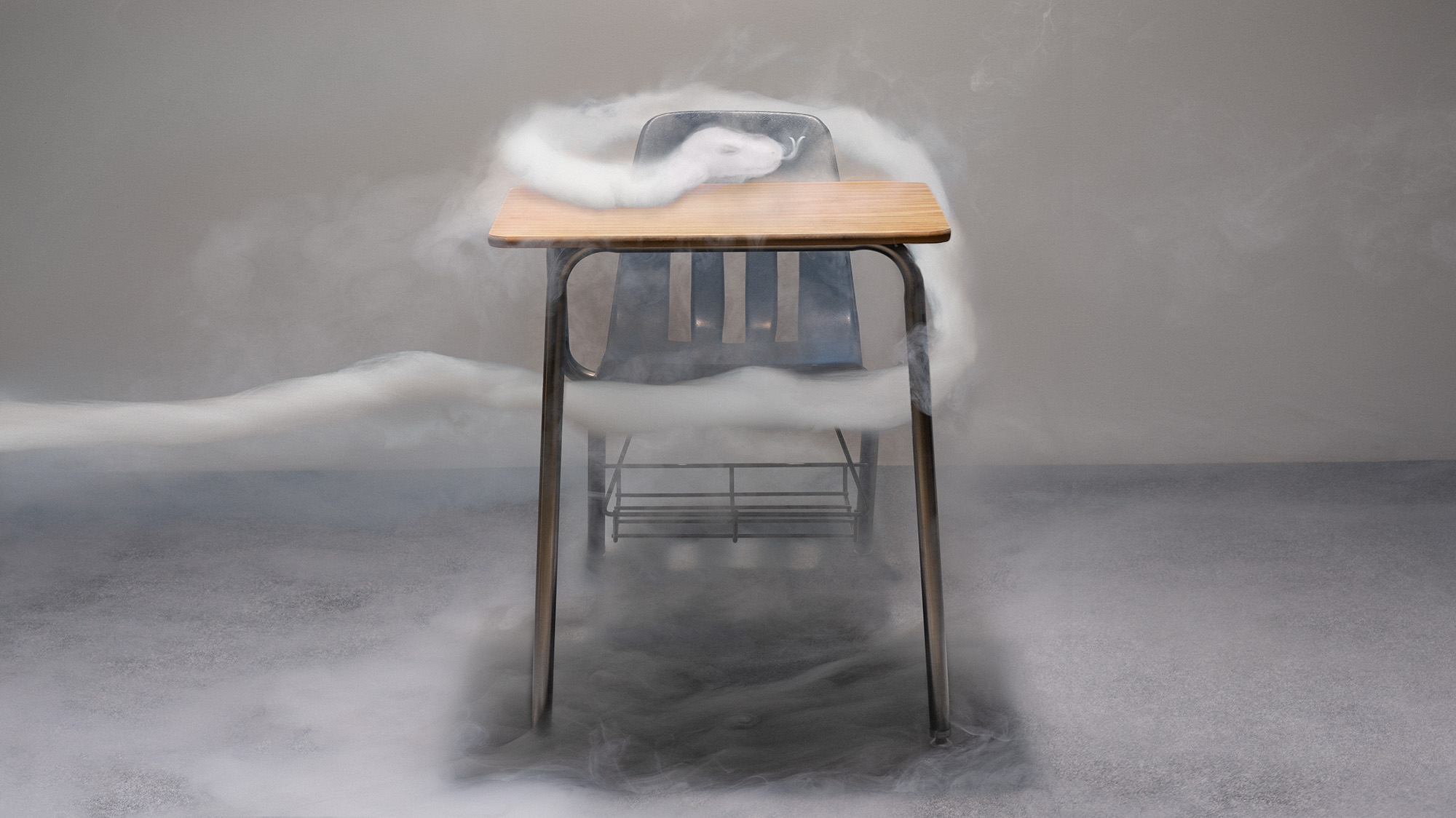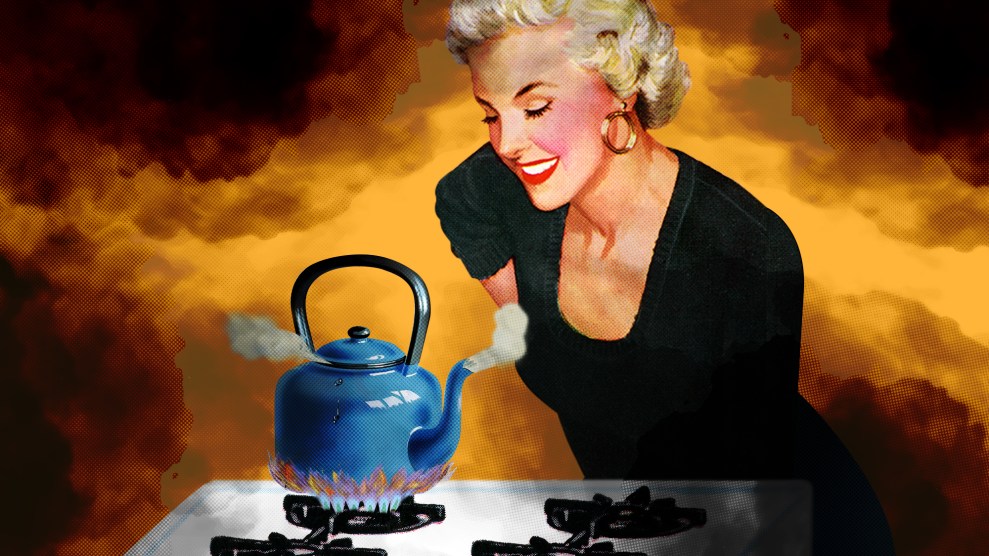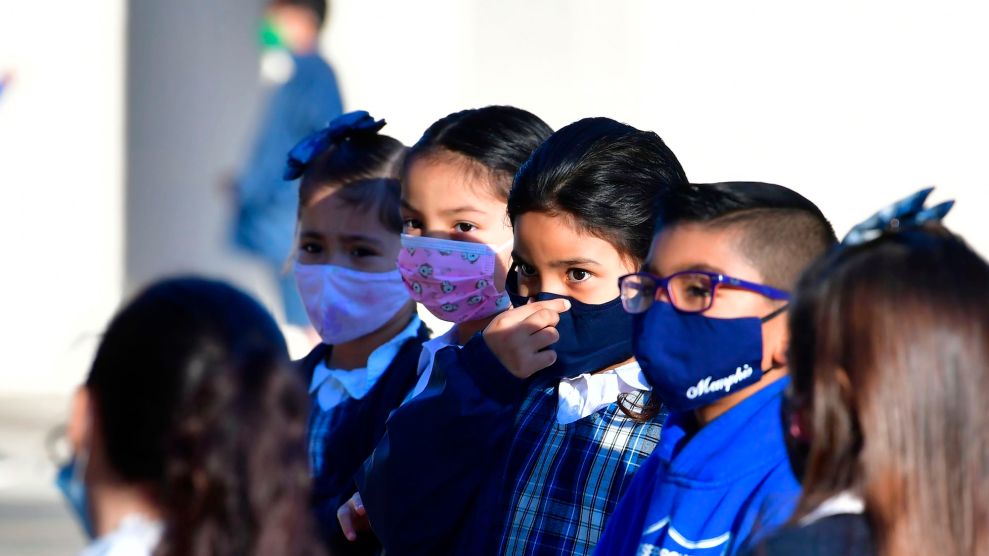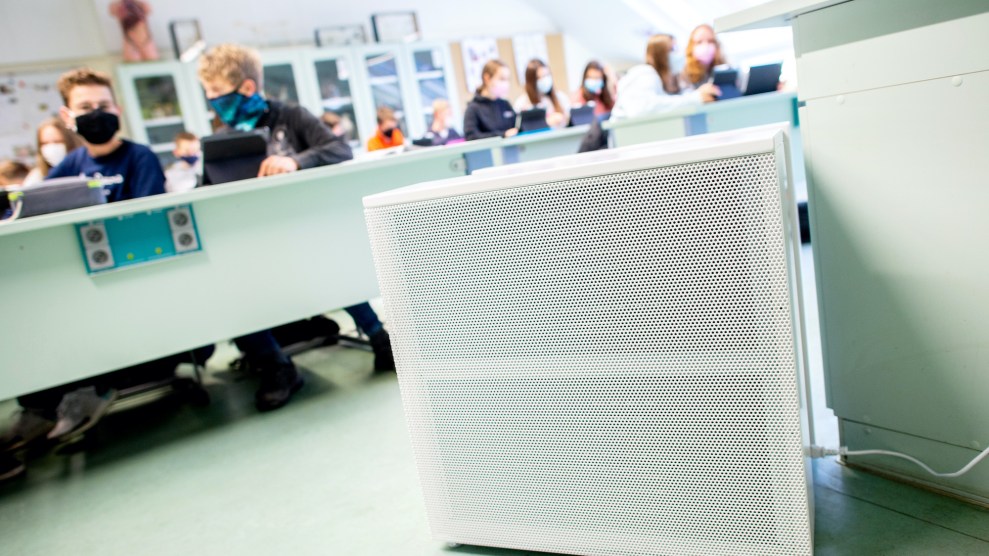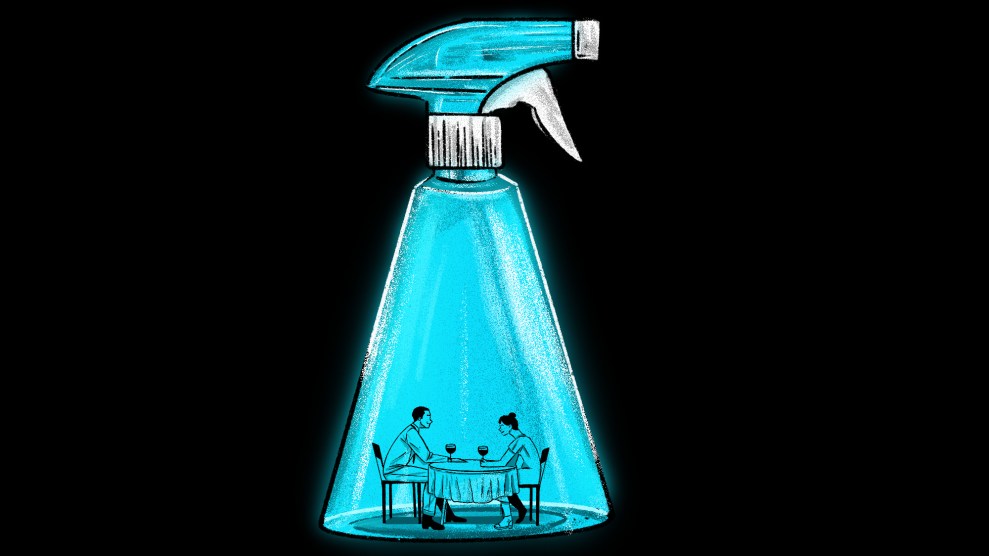Brandon Armbruster just wanted to keep his students safe. The chief operating officer of St. Andrew’s Episcopal School in Austin, Texas, Armbruster spent the spring and summer of 2020 diligently preparing for students to return—designing outdoor classrooms, setting up testing routines, and debating whether to cancel sports.
A private school with nearly 1,000 K–12 students on two campuses, St. Andrew’s had its own advisory committee of doctors and scientists to guide decisions about COVID. And as they learned more about how the coronavirus could hang suspended in aerosols for hours, the committee urged Armbruster to turn his attention to ventilation and ways to maximize the amount of fresh air St. Andrew’s could pump into its classrooms.
So when a contractor the school had worked with before suggested installing high-tech devices in air ducts to scrub out the coronavirus, Armbruster was intrigued. The devices used a technique called bipolar ionization, shooting tiny, electrically charged ions into the air, where they would interact with and neutralize airborne contaminants like viruses. Or, at least, that’s the theory. According to the manufacturer, Plasma Air, the Spanish Ministry of Defense had backed research that proved its purifier could reduce 99 percent of a coronavirus surrogate from the air in a Madrid hotel room within 10 minutes. All St. Andrew’s would need to do was attach Plasma Air’s small cartridges into its air ducts, hook them up to some electricity, and let the ionization process begin.
Armbruster, a 45-year-old business and finance guy, liked how the ionizers sounded more “proactive” than filters, which trap tiny contaminants as they float through air ducts or are sucked into the kind of free-standing air purifier you can buy at Home Depot. The contractor assured him that other Texas schools had already gone ahead with the technology. But Armbruster wasn’t convinced. For one thing, he couldn’t find much data on bipolar ionization that didn’t come directly from the companies peddling the products. And a video on the Plasma Air website raised red flags. In a science fair–style experiment captured on camera, two slices of bread were placed side by side in transparent boxes—one with a Plasma Air ionizer running, and one without. Over six days, mold blossomed across the bread in the non-ionized box; the other slice appeared fresh. “Yeah, it works great inside a small box,” Armbruster remembers thinking. “But what’s it going to do for a big classroom?”
To find out, he got in touch with Atila Novoselac and Pawel Misztal, two engineering professors and indoor air experts at the University of Texas, Austin. He asked if they would run tests on a couple of these ionizers before the school forked over more than $100,000. “Well, why not?” Novoselac recalls answering. They didn’t have access to a biosafety lab where they could test the ionizers against actual coronavirus. But they could measure whether the machines removed particles or broke down volatile organic compounds released in the air by household cleaning products, which would give them an idea of whether they worked as advertised. “We were quite excited initially,” Misztal says, “because we thought, ‘Wow, if this is really true, with those bold claims that the company was making, that should really help schools.’”
Yet when they turned on the ionizers in their own stainless steel chamber, the two engineers couldn’t detect any meaningful change in air quality. At first they thought the devices must not be working. After consulting the manual and running the tests again, they got the same results. Both researchers cautioned that their experiments were informal and confined to the two specific devices they tested. But the conclusions were unambiguous: “Installing this unit in a classroom’s HVAC was as good as putting a brick in a duct,” Novoselac wrote in an email to another researcher.

Armbruster passed on Plasma Air, instead opting to overhaul St. Andrew’s heating, ventilation, and air conditioning systems and add higher-efficiency filters. But Plasma Air’s slice of the air purifier industry is doing just fine without him. Since the onset of the pandemic, companies hawking indoor air cleaners have benefited from people’s fears over the air in their businesses, schools, and workplaces; an enormous amount of government and corporate money being spent to ensure those places can be reopened safely; and an almost entirely unregulated landscape in which to sell fancy-sounding but largely unproven technology.
The new universe of air scrubbers goes by a lot of names—bipolar ionization, photocatalytic oxidation, “organic air”—but some experts refer to them as “additive” purifiers. They all share the same underlying principle: Rather than simply subtracting matter from the air using a filter, they add molecules to create chemical reactions that, at least in theory, eliminate airborne contaminants. Those molecules supposedly float out into a room and destroy viruses, break down harmful gases, or make particles stick together, causing them to get trapped in filters or settle on surfaces, where they can’t be inhaled. Some manufacturers emphasize that their process mimics the atmospheric activity found near crashing waves, mountaintops, and waterfalls.
The reality is far less rosy. In interviews with Mother Jones, nearly a dozen chemists, engineers, and indoor air-quality experts laid out a range of possible dangers. First there’s the matter of the molecules that additive purifiers release into air, which can include ozone or free radicals. Ozone, a highly reactive form of oxygen, has long been known to damage lungs and worsen chronic respiratory diseases. While some purifiers are certified to produce undetectable levels of ozone, others produce much more. And little oversight exists to keep levels in check. Free radicals, meanwhile, have an odd number of electrons, which makes them unstable and greedy. When they meet other molecules, they grab their electrons, transforming into something new. While purifiers rely on those transformations to destroy unwanted gases, some research suggests free radicals may damage lung tissue when inhaled.
Experts also worry the machines run the risk of creating harmful byproducts like formaldehyde, a probable carcinogen at high concentrations. A federal class-action lawsuit filed in May against one of Plasma Air’s competitors, Global Plasma Solutions (GPS), alleges that bipolar ionizers “make the air worse for people” by causing toxic chemicals to form. In two recent studies conducted in China, researchers found that ionizing air purifiers tested in schools reduced particulate matter but also appeared to cause health problems. “Indoor air is a complex chemical soup,” explains Jeff Siegel, a University of Toronto civil engineering professor who has spent decades researching air cleaners. “If you’re operating one of these devices, the most charitable thing I can say is you are doing an uncontrolled experiment on the air in your building,” Siegel says. “In some environments, this could be really hazardous.”
In response to questions about scientists’ critiques, Plasma Air and GPS pointed to industry certifications saying their products emit negligible or no ozone. They also note test results from commercial labs that concluded their machines do not form chemical byproducts. (Four other companies did not respond to requests for comment or declined to answer questions about the scientists’ concerns.) GPS has filed defamation lawsuits against two of its critics, indoor air engineering consultants who said the company’s purifiers are unproven and potentially harmful, and that its product testing was faulty.
Manufacturers often pay commercial labs to test their products, resulting in impressive-sounding claims like a 99 percent reduction in airborne coronavirus. Meanwhile, peer-reviewed research does not show additive air purifiers consistently working under real-world conditions without forming potentially harmful byproducts, according to six academic experts I spoke with and a review of scientific articles provided by manufacturers. And recent research indicates that some machines on the market may be far less effective than manufacturers claim. Scientists have only begun to study the chemical mechanisms by which the purifiers actually work indoors, says Timothy Bertram, a University of Wisconsin chemist leading a study of bipolar ionizers. Without that understanding, it’s hard to evaluate what, if anything, additive purifiers do when they’re installed inside an air vent or plugged in at the back of a classroom. So far, Bertram’s study has found no evidence of the ionizers reducing aerosols.
“The theory behind these devices is interesting,” says Delphine Farmer, an atmospheric chemist at Colorado State University. “It’s just it hasn’t been demonstrated to work in real-world environments.”
At best, some experts say, additive purifiers are unnecessary, especially considering the range of proven alternatives like filters and increasing the flow of air coming in from outside. At worst, buyers hoping to fight COVID could be lulled into a false sense of security while adding harmful chemicals to the air. Yet over the last year, additive air cleaners have been installed in prisons, cruise ships, and meatpacking plants—all places where the coronavirus is known to spread rapidly. They are particularly attractive to schools, where administrators are under enormous pressure to resume in-person learning by the next school year. Those schools are also loaded with pandemic stimulus cash—$13 billion from 2020’s CARES Act, and an additional $130 billion in President Joe Biden’s American Rescue Plan. The familiar faces delivering the sell don’t hurt: Kris Kobach, the former Kansas secretary of state, was peddling an additive air cleaner to his state legislature last fall. Former CDC Director Robert Redfield recently joined manufacturer Big Ass Fans, which is selling fans with an additive purifier on the tip of each blade. In March, ActivePure Technologies, a Texas-based additive purifier company with a multilevel marketing arm, announced it was hiring a new chief medical and science adviser: Dr. Deborah Birx, Donald Trump’s former coronavirus response coordinator.
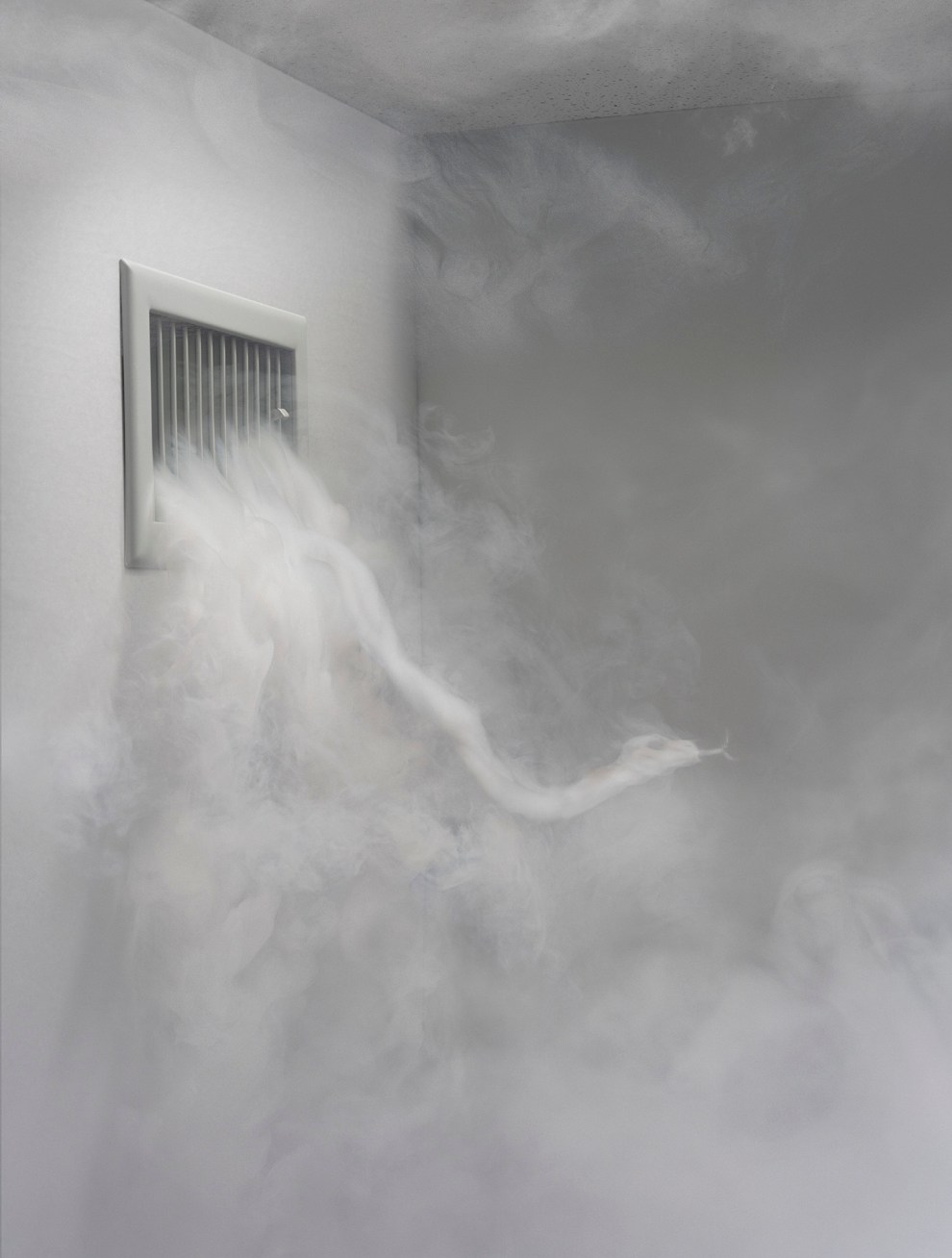
And so, across the country, school districts drawn in by promising-sounding manufacturer data and slick marketing are now spending anywhere from several thousand dollars to a few million to install additive air purifiers. GPS says its devices are employed by 1,300 K–12 schools and on 400 US college campuses. Both Plasma Air and ActivePure say hundreds of schools use their devices. According to a tally maintained by Marwa Zaatari, an indoor air engineering consultant, public and private schools in at least 41 states have installed air cleaners she’s concerned about. Marietta, Georgia, put ionizers on school buses. The school district in Sacramento, California, spent more than $6 million last year to purchase and install additive purifiers. “When the CARES Act dollars came through in late August, we saw it as a perfect opportunity to pursue ionization,” Greg Cole, a top administrator for Anoka-Hennepin Schools, one of Minnesota’s largest districts, says in a video posted to the district’s YouTube channel. The district spent more than $1.4 million on additive purifiers.
In January, the epidemic task force at ASHRAE, the professional organization that sets standards for HVAC, issued a recommendation that buildings should “only use air cleaners for which evidence of effectiveness and safety is clear.” The CDC urges consumers to “do their homework” on bipolar ionization: “In the absence of an established body of evidence reflecting proven efficacy under as-used conditions, the technology is still considered by many to be an ‘emerging technology.’”
But for many schools, installing high-tech air cleaners to fight an airborne virus still seems like the aggressive countermeasures that parents and staff clamor for. Richard Corsi, dean of the engineering and computer science college at Portland State University and an advocate for better-ventilated schools, says he’s fielded many queries from districts about bipolar ionizers and similar purifiers. “I just keep telling school district officials, ‘Stick to proven technologies,’” Corsi says. “‘Why would you want to risk this?’”

Additive air purifiers have been trendy before. In the early 2000s, the Sharper Image—the mall-based purveyor of shiny gadgets—relied on its Ionic Breeze purifier for more than a third of its sales. The device was supposed to generate ions that made contaminants stick to oppositely charged collection plates inside the device. No fan, no noise, just cleaner air. Then Consumer Reports published a series of articles beginning in 2002 finding that Ionic Breeze produced “almost no measurable reduction in airborne particles” but released potentially dangerous levels of ozone as an unintentional byproduct.
The findings spelled disaster for the Sharper Image. Ozone in the upper atmosphere shields humans from ultraviolet rays, but it’s toxic when inhaled, damaging lung tissue and aggravating asthma. The Sharper Image sued Consumer Reports for product disparagement and lost. Then the class actions started. Multiple lawsuits, from Ionic Breeze owners in California, Florida, and Maryland, claimed that the purifiers failed to work as advertised and exposed them to dangerous ozone levels.
After years of litigation, the company was ready to settle, proposing $19 coupons for anyone who owned an Ionic Breeze. But when the judge rejected the offer, the Sharper Image’s stock plummeted. Bankruptcy followed, and the company cited the lawsuits as a cause. The plaintiffs were allotted only a small settlement, but the controversy may have helped pass the country’s first and only prohibition on additive air purifiers: In 2008, California’s Air Resources Board banned air cleaners that emit more than a moderate amount of ozone.
As public knowledge about the dangers of indoor ozone grew, engineers set about redesigning ionizers, trying to avoid releasing significant levels of the gas. Today, manufacturers like Plasma Air and GPS boast that their devices produce tiny levels of ozone, if any at all. Still, small increases in ozone concentrations are associated with increased risk of death from respiratory causes, according to a study published in the New England Journal of Medicine, which compared 23 years of ozone data in 96 US cities with health outcomes for more than 400,000 patients.
Purifiers never went away—ask anyone who’s lived through the California wildfires—but the past year has brought them back into the national spotlight. In a video posted to ActivePure’s website, Birx explained her decision to join the company as a part-time consultant: “When I was traveling the country, I was able to talk to people and understand what their needs really were, how people really want to feel safe again indoors,” she said. “I was really looking for technology that was science- and data-driven, really working to address that specific issue, to make indoor spaces safe for individuals. ActivePure is one of those companies that has, really, that type of technology.” In a press release, CEO Joe Urso said Birx’s presence would help bring ActivePure devices to “all indoor spaces.”
Of course, Birx isn’t exactly regarded as a stalwart defender of science. As Trump’s coronavirus response coordinator, she became best known for sitting by uncomfortably as her boss wondered aloud about injecting bleach to treat COVID. Since Biden took office, Birx has been doing a series of TV hits to explain what happened, recounting how Trump chewed her out for issuing a dire warning about the coronavirus.
So working for a company that is also in need of image rehabilitation is an interesting choice. ActivePure is descended from Alpine Air Products, Inc., a multilevel marketing company founded in 1986 to sell free-standing air purifiers that intentionally generated ozone to clean the air. In 1990, the state of Minnesota, where Alpine was based, filed a consumer fraud and antitrust lawsuit against the company, alleging it hadn’t warned buyers that the amount of ozone emitted could be harmful. A trial court agreed, and Alpine had to pay consumers damages and restitution.
The company survived, and in 1994 it made $7 million in sales. But its legal problems didn’t go away. In 1995, the Federal Trade Commission told Alpine to stop making “unsubstantiated” claims about its purifiers’ ability to remove pollutants and prevent or relieve allergies, asthma, and colds. About three years later, after the company didn’t heed its warning, the FTC filed suit. A jury found Alpine lacked “competent and reliable scientific evidence” to back up many claims about its product’s effectiveness.
Then, in 2000, at the height of the company’s troubles, Mike Jackson, Alpine’s vice president of marketing—the very division responsible for its bogus claims—formed a new corporation: EcoQuest International. EcoQuest promptly acquired the marketing rights to sell Alpine products, along with its entire network marketing operation.
With the bombastic Jackson as president, EcoQuest grew from a small multilevel marketing firm to a powerhouse. In radio ads, Pat Boone sang the praises of its purifiers, which the company claimed produced less ozone than older versions. Thousands of dealers flocked to the EcoQuest Success Institute in Greeneville, Tennessee, for sales training programs steeped in religious language. Many of its most successful salespeople were “pastors and priests and preachers and evangelists,” Jackson told a Knoxville News Sentinel reporter. (In this sense, Birx, an evangelical, fits right in.) “I don’t believe that the non-Christian crowd should control all the money and should control all the airways and control the radio waves and control all the newspapers,” Jackson said. (When California debated its air purifier regulation, an EcoQuest dealer wept during a public hearing as she described how the company’s product had improved her mother’s breathing. “God gave humans these air purifiers, and you should not take away that gift,” she pleaded.)
By 2004, EcoQuest’s cumulative air purifier sales had reportedly reached $1 billion. That summer, the company acquired a division of another firm that had a pending patent on a related process called photocatalytic oxidation, which involves shining ultraviolet light onto a surface coated with a catalyst. When working as intended, that interaction creates charged clusters of oxygen and hydrogen in the air, as well as free radicals, that break down unwanted gases into water and carbon dioxide. The way the company tells the story, the technique drew on NASA research looking for ways to reduce the buildup of ethylene gas around plants inside a spacecraft’s sealed environment. EcoQuest dubbed the technology ActivePure and got to work selling it.
At least some of the new purifiers still released ozone. But Jackson assured the Knoxville News Sentinel that Alpine’s legal troubles were a thing of the past: “All that stuff was the maturing, the growing of Mike Jackson as a businessman,” he said. “I learned that you don’t make claims unless you have scientific substantiation…It probably was one of the best schools I could have gone to in learning what not to do with my company.”
But in 2009, when sales plummeted amid the recession, EcoQuest went bankrupt. Jackson sold off EcoQuest to Urso, CEO of a family of companies with names like Allergy Buyers Club—and descended from Electrolux, the door-to-door sales heavyweight—that used direct sales to hawk anti-allergy bedding, aromatherapy oils, and vacuum cleaners. (According to a press release, the company signed a deal in 2018 to manufacture purifiers under the brand name the Sharper Image, though Urso says this has not happened.)
Today, ActivePure is the name of Urso’s flagship company and his signature product, sold both as an HVAC add-on and in free-standing air purifiers. In an email, Urso told me that their technology, improved since the EcoQuest days, complies with all federal standards “with respect to efficacy and safety” and reduces net ozone. “Our goal at ActivePure Technologies has been and is simple: finding the best path to clean and safe indoor air,” he wrote. One ActivePure product, the Medical Guardian, which uses a HEPA filter and ionizer with photocatalytic oxidation, has been certified by the FDA as a medical device to remove certain viruses, bacteria, and fungal spores from the air in hospitals and doctors’ offices—indicating it doesn’t produce high ozone levels. A “handful” of the company’s products, Urso added, produce ozone intentionally.
Jackson, for his part, is now a leader in ActivePure’s multilevel marketing arm, which is still going strong. In a June 2020 recruitment webinar titled “How You Earn $100,000 Killing Viruses, Mold, and Mildew!” Jackson suggested that sellers can pay off their mortgage after six months of hawking air purifiers. (Urso says Jackson is an independent distributor whose views do not represent the company.)
Urso’s companies make the jaw-dropping claim that their technology can kill more than 99 percent of airborne coronavirus in three minutes. The powerful oxidants produced by the purifiers “seek and destroy DNA and RNA viruses,” according to some of the company’s marketing language. Sales have quadrupled over the last year, a press release boasts; in one promotional video, Jackson claims they “sold out” 25,000 systems in a single week in 2020. The ActivePure website now lists 39 schools and child care centers it says use its purifiers; “hundreds more,” it claims, “trust” its technology.
“We developed technology, called ActivePure, that destroys the COVID virus in the air and have deployed it for decades,” Urso wrote in an open letter to Biden on his company’s website. “I urge you and the nation’s governors and mayors to encourage—or, where you can, require—the use of the best technology now. It is the missing link. Bringing America back depends on it.”

Peg Pavelec first heard of ActivePure from a friend’s sister, a direct salesperson for its multilevel marketing arm. Pavelec, the owner of Little Inspirations preschool and day care in Hyde Park, Chicago, hadn’t much obsessed over ventilation during the city’s hot summer last year, when the roughly 85 kids her staff looked after spent a lot of time in the neighborhood’s green spaces. “Our program is very nature-based,” she says. “We try to get outdoors as much as possible.”
But when the winter came and COVID cases surged, she started to focus more on indoor air quality. When her friend’s sister reached out in late 2020, Pavelec was eager to learn more. The woman, she recalls, talked a lot about the science behind the device. “Some of it was all gibberish, because it’s very technical,” she says. “But as the conversation continued, it became much more layperson friendly. There’s little animated videos, sharing how the units work, and what they do, and how they kill 99 percent of the viruses out there.”
Pavelec loved what she heard—including the part about how ActivePure was considered a “Certified Space Technology.” Because the company’s photocatalytic oxidation technique draws on science developed by NASA, the company can pay a licensing fee to the Space Foundation, a nonprofit that is not run by NASA, to put the foundation’s stamp of approval on its ActivePure products. Other certified technologies include a line of South Korean skin care and the KegSheet, a $14 beer keg insulator. “It’s like rocket fuel for your brand!” reads a banner across the Space Foundation webpage. “Wow, this is NASA,” Pavelec remembers thinking about ActivePure. “If it really works the way they say it works, that could be life-changing.”
But Pavelec paused at the cost: up to $10,000 to outfit both her child care locations. Before she pulled the trigger, she emailed Brent Stephens, the father of two children in her program and an indoor air expert at the Illinois Institute of Technology. “I would not jump on this,” Stephens wrote back to her. He was especially worried about the potential for the purifiers to generate free radicals, which could be expected to react with all sorts of chemical compounds in the air and turn them into other molecules. A 2018 Environmental Protection Agency report supports the idea that these types of devices could generate formaldehyde, as well as nitrogen dioxide and carbon monoxide, because of the free radicals it creates. The EPA concludes: “The effectiveness of [photocatalytic oxidation] air cleaners sold for use in homes remains largely undocumented.” “The new daughter molecules that are produced can be even more toxic than the original parent,” Stephens explained to Pavelec. The kids could end up breathing higher levels of formaldehyde.
At the request of Mother Jones, Stephens analyzed the data that is the basis for ActivePure’s claim to reduce 99 percent of aerosolized coronavirus. The stand-alone purifier used in the experiment is advertised for rooms between 500 and 3,000 square feet, yet it was tested in a box the size of an oven. “Crazy outsized device in a tiny chamber,” Stephens concluded. “Standard trick.” Bud Offermann, another indoor air engineering consultant I asked to review the data, agreed. At best, he said, the study showed “proof of concept.” (According to Urso, ActivePure does not produce volatile organic compounds. He “does not agree that a small chamber invalidates the basic conclusion that the technology deactivates” the coronavirus.)
“These are concerning,” says Farmer, the Colorado State University atmospheric chemist, who also reviewed ActivePure’s test data. “I would leave a room quickly and would dissuade anyone with asthma or other cardiorespiratory conditions from getting near until they went through more tests for byproducts.”
Farmer also warned another school administrator, Chris Wilderman, about a different type of additive purifier: bipolar ionizers. Wilderman, the director of maintenance and operations for one of Colorado’s largest districts, was helping to decide how to spend millions in CARES Act funding. Last summer, he installed bipolar ionizers from Global Plasma Solutions in two schools that couldn’t bring enough outside air into classrooms. He was considering putting GPS units in more buildings when he heard Farmer talking about indoor air quality on NPR. Farmer, at the time, was working with other scientists on what they believe is the first peer-reviewed study assessing whether bipolar ionization reduces particulates or forms byproducts in a real-life setting—examining, coincidentally, GPS devices. Though the study, published in March, did not look at the effect of ionizers on viruses, it found that the machines did little to reduce particulate matter in both a test chamber and an occupied office building. And while the purifier appeared to break down some concerning gases, it seemed to produce small increases in others, like acetaldehyde and toluene, which the EPA classifies as hazardous. (One bright spot: the researchers concluded the system was not producing ozone.)
GPS says it disagrees with the study’s results, arguing the authors did not design their experiment properly. “GPS and its leadership doesn’t just appreciate, but enthusiastically encourages the testing” of its technology, the company said in a statement. It also stressed that those studies need to be “accurately replicating real-world applications of the products.” But it’s not just Farmer raising alarms about GPS. In May, the company was hit with a class-action lawsuit alleging GPS deceives consumers by falsely claiming its technology is independently tested and that it “preys on people desperate to cleanse the air and protect themselves.” The complaint continues: “Defendant’s ‘profits over people’ scheme won the company acclaim, publicity, and generated hundreds of millions of dollars in sales.” GPS told me it intends “to aggressively defend our technology and claims.”
Wilderman says Farmer’s advice was “don’t get fancy.” He decided to put air purifiers with HEPA filters in every classroom in the district. “SARS-CoV-2 is transmitted through exhaled aerosols,” Farmer explains. “One way to really reduce that risk is to remove as many particles as you can from the air. That’s what having a HEPA filter is designed for.” For Wilderman, outfitting a single high school with 143 free-standing HEPA purifiers cost $26,884. Putting in GPS ionizers in that same school would have run about $350,000. (GPS points out that its ionizers don’t require replacement filters.)
Pavelec, in Chicago, wavered after her friend’s sister sent her a trial ActivePure device, but she ultimately said no to the purifiers. Still, not every school has a Stephens or Farmer to consult with. In northern Virginia, Rappahannock County is home to two public schools, about 800 students, and zero stoplights. Robin Bolt wears a lot of hats for the school district, overseeing technology, facilities, and equity. Last year, when Bolt requested bids to install “air scrubbers,” ActivePure came back as the cheapest option. To Bolt, the manufacturer data was promising, and online reviews sounded good. For just over $126,000, the district installed one model in the ducts and put free-standing versions in its offices.
Since then, Bolt has heard from a school nurse that sicknesses have gone down; the air inside, to her, smells fresher. But she’s unsurprised to hear that there’s little peer-reviewed science backing up her district’s new purifiers. “We’re flying by the seat of our pants,” she says. “We’re trying to do what is best for our students. That’s always the endgame.”
“The specs looked very good,” she added. “And then that NASA seal sort of makes you feel a lot better about it.”

As scientists have started to raise alarms, some institutions have reversed course on additive air purifiers. In February, the Sacramento school district pulled photocatalytic oxidation machines from school buildings after outcry from the teachers union. Public schools in Montclair, New Jersey, turned off their GPS ionizers after parent objections. And last summer, when a Phoenix megachurch hosting a Trump rally announced it had installed purifiers that could supposedly kill “99 percent of COVID within 10 minutes,” backlash from experts led the state attorney general to issue warning letters to both the church and the company, Clean Air EXP. Each rolled back its claims. (Clean Air EXP rebranded four months later. It now sells under the name PuriFi Labs.)
Yet no US governmental body has attempted to regulate the indoor air cleaner industry systematically. Products that can’t pass California’s ozone test are sold freely in other states; one ActivePure website, for example, serves different homepages to customers outside the state. The FTC has sent warning letters to a handful of air purifier companies making COVID-related claims but has not publicly announced any follow-up action, according to a spokesperson. And while the FDA regulates medical devices, it’s up to companies to decide whether to seek that certification. In an email to Mother Jones, an EPA spokesperson said it keeps an eye on false and misleading claims from air purifier manufacturers but that companies aren’t required to submit safety or efficacy data to the agency. “EPA is concerned about the potential for schools to be victimized,” the spokesperson said. But enforcement, for now, is case by case.
“These products just fall in that gray zone where no government authority is really ready to provide oversight or regulation for them,” Farmer says. “It’s probably not going to happen until someone gets really badly hurt.”
All the scientists I spoke with say that the goal should be more peer-reviewed research on what exactly additive cleaners are doing. In the meantime, indoor air-quality experts are urging schools to follow the precautionary principle: “If you don’t understand it, do not use it,” Zaatari says. She’s working on an ASHRAE standard for additive air-cleaner testing and raising money for more research. A handful of scientists recently released an online tool to help convert additive purifier manufacturer data into more informative metrics. Corsi, Stephens, and others have all given webinars cautioning schools to stick to proven methods like increasing the flow of outdoor air and upgrading filters. Farmer, in conversations with school administrators, has recommended they simply duct-tape HEPA filters to box fans: $50 apiece, no risk of byproducts.
And in April, a dozen indoor air-quality scientists and engineers co-signed an open letter to schools written by Zaatari and another consultant. “Many districts, constrained by varying degrees of limited budgets, deferred maintenance, and pressure to get kids back in school, have already implemented electronic air cleaning devices, relying on incomplete data and exaggerated claims to make a well-intended, but incorrect decision,” they wrote. “Despite the resources invested, we recommend that these districts strongly consider turning off or disabling these electronic air cleaners to prevent unintended harm to building occupants.”
At least one purifier company is firing back at its critics. This spring, GPS filed lawsuits accusing Zaatari and Offermann of defamation and product disparagement. Offermann, who spent decades testing additive air purifiers for the Lawrence Berkeley National Laboratory, had self-published a paper titled “Beware: The COVID-19 Snake Oil Salesmen Are Here,” which GPS claims unfairly maligned its test data, according to court papers. In a separate complaint, GPS accused Zaatari of mounting “a systematic campaign designed to smear GPS” on Twitter, in news articles, and during webinars that portrayed ionizers as potentially dangerous—including likening them to cigarettes. “They’re basically suing to try to silence me,” Zaatari told me in April. “I’m not going to stop.”
It’s an uphill battle at a time when institutions are looking to do anything possible to fight the coronavirus. For Armbruster, in Texas, finding ways to stop the spread of COVID in school “immediately took precedence over everything else that we had planned.” Wilderman, in Colorado, spent months sorting through a bombardment of air purifier marketing. “We were getting flooded every day, from everybody you can think of—individual air purifiers, HEPA filters, UV light, dry hydrogen peroxide,” he recalls. Contractors cold-called him. School board members forwarded sales emails.
Pavelec, the day care and preschool owner, worries about what parents might think if they learn she turned down any technology that could potentially offer COVID protection. “People have strong opinions about this,” she says. “People say, ‘Well, you should be doing everything that you possibly can to make sure every moment, every particle is eliminated.’ There’s a lot of fear. And there’s a lot of tragedy that’s already come around.”
She understands their perspective—and the purifiers’ allure. When she tried out an ActivePure device as a sample, she put it in her basement and allowed her son to have a friend over. For a short time, she was a little less anxious. Then she began to wonder if she had a false sense of security. “That view that there’s this new technology that could be the solution is really enticing,” she says. “You want to believe it.”
An earlier version of this story misstated when the Sacramento teachers union raised concerns about the district’s purifiers.
